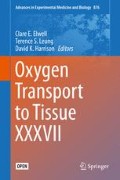Abstract
The method of capillary domains has often been used to study capillarization of skeletal and heart muscle. However, the conventional data processing method using a digitizing tablet is an arduous and time-consuming task. Here we compare a new semi-automated capillary domain data collection and analysis in muscle tissue with the standard capillary domain method. The capillary density (1481 ± 59 vs. 1447 ± 54 caps mm−2; R2:0.99; P < 0.01) and heterogeneity of capillary spacing (0.085 ± 0.002 vs. 0.085 ± 0.002; R2:0.95; P < 0.01) were similar in both methods. The fiber cross-sectional area correlated well between the methods (R2:0.84; P < 0.01) and did not differ significantly (~8 % larger in the old than new method at P = 0.08). The latter was likely due to differences in outlining the contours between the two methods. In conclusion, the semi-automated method gives quantitatively and qualitatively similar data as the conventional method and saves a considerable amount of time.
Access this chapter
Tax calculation will be finalised at checkout
Purchases are for personal use only
References
Ahmed SK, Egginton S, Jakeman PM et al (1997) Is human skeletal muscle capillary supply modelled according to fibre size or fibre type? Exp Physiol 82(1):231–234
Degens H, Turek Z, Hoofd LJ et al (1992) The relationship between capillarisation and fibre types during compensatory hypertrophy of the plantaris muscle in the rat. J Anat 180(Pt 3):455–463
Wust RC, Gibbings SL, Degens H (2009) Fiber capillary supply related to fiber size and oxidative capacity in human and rat skeletal muscle. Adv Exp Med Biol 645:75–80
Wust RC, Jaspers RT, van Heijst AF et al (2009) Region-specific adaptations in determinants of rat skeletal muscle oxygenation to chronic hypoxia. Am J Physiol Heart Circ Physiol 297(1):H364–H374
Hoofd L, Turek Z, Kubat K et al (1985) Variability of intercapillary distance estimated on histological sections of rat heart. Adv Exp Med Biol 191:239–247
Degens H, Ringnalda BE, Hoofd LJ (1994) Capillarisation, fibre types and myoglobin content of the dog gracilis muscle. Adv Exp Med Biol 361:533–539
Degens H, Deveci D, Botto-van Bemden A et al (2006) Maintenance of heterogeneity of capillary spacing is essential for adequate oxygenation in the soleus muscle of the growing rat. Microcirculation 13(6):467–476
Al-Shammari AA, Gaffney EA, Egginton S (2012) Re-evaluating the use of Voronoi Tessellations in the assessment of oxygen supply from capillaries in muscle. Bull Math Biol 74(9):2204–2231
Liu G, Mac Gabhann F, Popel AS (2012) Effects of fiber type and size on the heterogeneity of oxygen distribution in exercising skeletal muscle. PLoS One 7(9):e44375
Al-Shammari AA, Gaffney EA, Egginton S (2014) Modelling capillary oxygen supply capacity in mixed muscles: capillary domains revisited. J Theor Biol 356c:47–61
Hoofd L, Degens H (2013) Statistical treatment of oxygenation-related data in muscle tissue. Adv Exp Med Biol 789:137–142
Weerappuli DP, Popel AS (1989) A model of oxygen exchange between an arteriole or venule and the surrounding tissue. J Biomech Eng 111(1):24–31
Beard DA, Bassingthwaighte JB (2000) Advection and diffusion of substances in biological tissues with complex vascular networks. Ann Biomed Eng 28(3):253–268
Suzuki J, Gao M, Batra S et al (1997) Effects of treadmill training on the arteriolar and venular portions of capillary in soleus muscle of young and middle-aged rats. Acta Physiol Scand 159(2):113–121
Hoofd L (1995) Calculation of oxygen pressures in tissue with anisotropic capillary orientation. II. Coupling of two-dimensional planes. Math Biosci 129(1):25–39
Hoofd L, Degens H (2009) The influence of flow redistribution on working rat muscle oxygenation. Adv Exp Med Biol 645:55–60
Acknowledgments
This research was funded by the European Commission through MOVE-AGE, an Erasmus Mundus Joint Doctorate program (2011–2015). The Matlab codes are available from the authors on request.
Author information
Authors and Affiliations
Corresponding author
Editor information
Editors and Affiliations
Rights and permissions
Copyright information
© 2016 Springer Science+Business Media, New York
About this paper
Cite this paper
Ballak, S.B., Yap, M.H., Harding, P.J., Degens, H. (2016). Validation of a New Semi-Automated Technique to Evaluate Muscle Capillarization. In: Elwell, C.E., Leung, T.S., Harrison, D.K. (eds) Oxygen Transport to Tissue XXXVII. Advances in Experimental Medicine and Biology, vol 876. Springer, New York, NY. https://doi.org/10.1007/978-1-4939-3023-4_11
Download citation
DOI: https://doi.org/10.1007/978-1-4939-3023-4_11
Publisher Name: Springer, New York, NY
Print ISBN: 978-1-4939-3022-7
Online ISBN: 978-1-4939-3023-4
eBook Packages: Biomedical and Life SciencesBiomedical and Life Sciences (R0)

